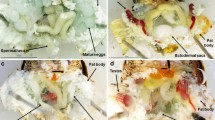Abstract
The paper focuses on the influence of the day length on larval and pupal development of the dark spectacle Abrostola triplasia (Lepidoptera, Noctuidae: Plusiinae, Abrostolini) in the central European Russia (50°N, 36°E). The long-day qualitative photoperiodic response of diapause induction controls formation of the winter pupal diapause and determines a bivoltine seasonal cycle of the species in the forest-steppe zone. Seasonal development of the local population of A. triplasia has the following peculiarity: if adults of the overwintered generation emerge late (in the second half of June), larvae of the first generation develop under the critical, or threshold, daylength conditions, which results in the presence of both diapausing and non-diapausing fractions of the pupae. The diapausing pupae overwinter, whereas the non-diapausing ones develop into adults that produce the second generation; the pupae of this second generation overwinter. Therefore, the hibernating population of A. triplasia consists of individuals from both generations. Thus, the dark spectacle has a very flexible seasonal development pattern in the forest-steppe zone: the presence of two generations allows the species to fully utilize the resources of the vegetation season; at the same time, the first generation already has a reserved hibernating fraction in case the weather conditions of the particular year are not favorable for completion of two generations.
Similar content being viewed by others
References
Danilevsky, A.S., Photoperiodism and Seasonal Development of Insects (Leningrad State Univ., Leningrad, 1961) [in Russian].
Danks, H.V., Insect Dormancy: An Ecological Perspective (Biological Survey of Canada, Ottawa, 1987).
Förare, J., “The Biology of the Noctuid Moth Abrostola asclepiadis Schiff. (Lepidoptera, Noctuidae) in Sweden,” Entomol. Tidsk. 116 (4), 179–186 (1995).
Goryshin, N.I., Volkovich, T.A., and Saulich, A.Kh., “Some Results of Research of Insect Photoperiodism in the Les na Vorskle Reserve,” in Complex Research of the Biocenoses of Forest-Steppe Oakeries (Leningrad, 1986), pp. 74–92 [in Russian].
Klyuchko, Z.F., The Noctuid Moths of Ukraine (Izd. Raevskogo, Kiev, 2006) [in Ukrainian].
Koch, M., Wir bestimmen Schmetterlinge (Radebeul, Berlin, 1958).
Lafontaine, J.D. and Schmidt, B.C., “Annotated Check List of the Noctuoidea (Insecta, Lepidoptera) of North America North of Mexico,” ZooKeys 40, 1–239 (2010).
Lopatina, E.B., Balashov, S.V., and Kipyatkov, V.E., “First Demonstration of the Influence of Photoperiod on the Thermal Requirements for Development in Insects and in Particular the Linden-Bug, Pyrrhocoris apterus (Heteroptera: Pyrrhocoridae),” Europ. J. Entomol. 104, 23–31 (2007).
Matov, A.Yu., Kononenko, V.S., and Sviridov, A.V., “Noctuidae,” in Catalogue of Lepidoptera of Russia, Ed. by S.Yu. Sinev (KMK Sci. Press, Moscow, 2008), pp. 239–296[in Russian].
Mazzei, P., Morel, D., and Panfili, R., Moths and Butterflies of Europe and North Africa (1999), http://www.leps.it/indexjs.htm?SpeciesPages/AbrosTripa.htm.
Merzheevskaya, O.I., Larvae of Noctuid Moths: Biology and Morphology (Nauka i Tekhnika, Minsk, 1967) [in Russian].
Musolin, D.L. and Saulich, A.Kh., “Photoperiodic Control of the Nymphal Growth in True Bugs (Heteroptera),” Zool. Zh. 76 (5), 530–540 (1997) [Entomol. Rev. 77 (6), 768–780 (1997)].
Saulich, A.Kh., The Seasonal Development of Insects and the Possibilities of Their Dispersal (St. Petersburg State Univ., St. Petersburg, 1999) [in Russian].
Saulich, A.H. and Musolin, D.L., “Four Seasons: Diversity of Seasonal Adaptations and Ecological Mechanisms Controlling Seasonal Development in True Bugs (Heteroptera) in the Temperate Climate,” in Adaptive Strategies of Terrestrial Arthropods to Unfavourable Environmental Conditions: A Collection of Papers in Memory of Professor Viktor Petrovich Tyshchenko, Ed. by Stekolnikov, A.A. (2007) (Proceedings of the Biological Institute of St. Petersburg State University) vol. 53, pp. 25–106 [in Russian with English summary].
Saulich, A.Kh. and Sokolova, I.V., “Effects of Temperature and Day Length on the Control of Seasonal Development of Noctuid Moth Emmelia trabealis L. (Lepidoptera: Noctuidae),” Entomol. Obozr. 80 (1), 3–7 (2001) [Entomol. Rev. 81 (4), 375–378 (2001)].
Saulich, A.Kh. and Sokolova, I.V., “Seasonal Adaptations in Noctuid Moths (Lepidoptera, Noctuidae),” Entomol. Obozr. 81 (3), 529–546 (2002) [Entomol. Rev. 82 (9), 1127–1141 (2002)].
Saulich, A.Kh. and Volkovich, T.A., Ecology of Insect Photoperiodism (St. Petersburg State Univ., St. Petersburg, 2004) [in Russian].
Sokolova, I.V., “Geographical Variation of Photoperiodic Response in the Spotted Sulphur Euclidia gliphica L. (Lepidoptera, Noctuidae),” Kavkaz. Entomol. Byull. 2 (2), 199–203 (2006).
Sokolova, I.V., “Univoltine Seasonal Cycle and Obligate Diapause in the Noctuid Moth Charanyca trigrammica Hufn. (Lepidoptera, Noctuidae),” Entomol. Obozr. 86 (3), 489–497 (2007) [Entomol. Rev. 87 (7), 793–798 (2007)].
Sokolova, I.V., “Photoperiodical Control of Larval Development and Diapause of Hoplodrina blanda ([Denis & Schiffermüller], 1775) (Lepidoptera, Noctuidae) in the Forest-Steppe Zone of Russia,” Evraziat. Entomol. Zh. 2 (7), 182–188 (2008).
Sokolova, I.V. and Saulich, A.Kh., “The Photoperiodic Control of Diapause of Protoschinia scutosa Den. et Schiff. (Lepidoptera, Noctuidae) in the Forest-Steppe Zone,” Vestnik Sankt-Peterburg. Univ. Ser. 3 Biol. 1 (3), 35–40 (2002).
Tyshchenko, V.P., Volkovich, T.A., and Lanevich, V.P., “The Intermediate Photoperiodic Response and Its Role in Regulation of the Seasonal Development of the Flame Axylia putris L. (Lepidoptera, Noctuidae),” Entomol. Obozr. 62 (2), 225–234 (1983).
Author information
Authors and Affiliations
Corresponding author
Additional information
Original Russian Text © A.Kh. Saulich, I.V. Sokolova, D.L. Musolin, 2015, published in Entomologicheskoe Obozrenie, 2015, Vol. 94, No. 3, pp. 481–488.
Rights and permissions
About this article
Cite this article
Saulich, A.K., Sokolova, I.V. & Musolin, D.L. Seasonal development of the dark spectacle Abrostola triplasia (L.) (Lepidoptera, Noctuidae) and its environmental control. Entmol. Rev. 95, 687–692 (2015). https://doi.org/10.1134/S0013873815060019
Received:
Published:
Issue Date:
DOI: https://doi.org/10.1134/S0013873815060019



